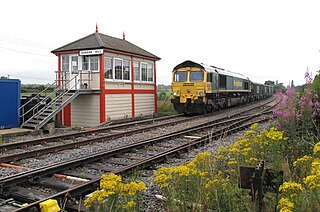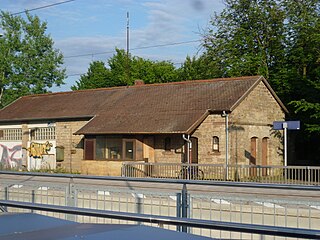Related Research Articles

A railway signal is a visual display device that conveys instructions or provides warning of instructions regarding the driver's authority to proceed. The driver interprets the signal's indication and acts accordingly. Typically, a signal might inform the driver of the speed at which the train may safely proceed or it may instruct the driver to stop.

On a rail transport system, signalling control is the process by which control is exercised over train movements by way of railway signals and block systems to ensure that trains operate safely, over the correct route and to the proper timetable. Signalling control was originally exercised via a decentralised network of control points that were known by a variety of names including signal box, interlocking tower and signal cabin. Currently these decentralised systems are being consolidated into wide scale signalling centres or dispatch offices. Whatever the form, signalling control provides an interface between the human signal operator and the lineside signalling equipment. The technical apparatus used to control switches (points), signals and block systems is called interlocking.

Railway signalling (BE), also called railroad signaling (AE), is a system used to control the movement of railway traffic. Trains move on fixed rails, making them uniquely susceptible to collision. This susceptibility is exacerbated by the enormous weight and inertia of a train, which makes it difficult to quickly stop when encountering an obstacle. In the UK, the Regulation of Railways Act 1889 introduced a series of requirements on matters such as the implementation of interlocked block signalling and other safety measures as a direct result of the Armagh rail disaster in that year.

In railway signalling, an interlocking is an arrangement of signal apparatus that prevents conflicting movements through an arrangement of tracks such as junctions or crossings. In North America, a set of signalling appliances and tracks interlocked together are sometimes collectively referred to as an interlocking plant or just as an interlocking. An interlocking system is designed so that it is impossible to display a signal to proceed unless the route to be used is proven safe.

Centralized traffic control (CTC) is a form of railway signalling that originated in North America. CTC consolidates train routing decisions that were previously carried out by local signal operators or the train crews themselves. The system consists of a centralized train dispatcher's office that controls railroad interlockings and traffic flows in portions of the rail system designated as CTC territory. One hallmark of CTC is a control panel with a graphical depiction of the railroad. On this panel, the dispatcher can keep track of trains' locations across the territory that the dispatcher controls. Larger railroads may have multiple dispatcher's offices and even multiple dispatchers for each operating division. These offices are usually located near the busiest yards or stations, and their operational qualities can be compared to air traffic towers.

A track circuit is an electrical device used to prove the absence of a train on rail tracks to signallers and control relevant signals. An alternative to track circuits are axle counters.

The European Train Control System (ETCS) is a train protection system designed to replace the many incompatible systems used by European railways, and railways outside of Europe. ETCS is the signalling and control component of the European Rail Traffic Management System (ERTMS).

Linienzugbeeinflussung is a cab signalling and train protection system used on selected German and Austrian railway lines as well as on the AVE and some commuter rail lines in Spain. The system was mandatory where trains were allowed to exceed speeds of 160 km/h (99 mph) in Germany and 220 km/h (140 mph) in Spain. It is also used on some slower railway and urban rapid transit lines to increase capacity. The German Linienzugbeeinflussung translates to continuous train control, literally: linear train influencing. It is also called linienförmige Zugbeeinflussung.

Union Switch & Signal was an American company based in Pittsburgh, Pennsylvania, which focused on railway signaling equipment, systems and services. The company was acquired by Ansaldo STS in 1988, operating as a wholly-owned company until January 2009, when US&S was renamed "Ansaldo STS USA" to operate as a subsidiary of Ansaldo in the Americas and Asia.

Most trains on the New York City Subway are manually operated. As of 2022, the system currently uses Automatic Block Signaling, with fixed wayside signals and automatic train stops. Many portions of the signaling system were installed between the 1930s and 1960s. Because of the age of the subway system, many replacement parts are unavailable from signaling suppliers and must be custom-built for the New York City Transit Authority, which operates the subway. Additionally, some subway lines have reached their train capacity limits and cannot operate extra trains in the current system.
The Toronto subway uses a variety of signalling systems on its lines, consisting of a combination of fixed block signalling and moving block signalling technologies.

Mechanical railway signalling installations rely on lever frames for their operation to interlock the signals, track locks and points to allow the safe operation of trains in the area the signals control. Usually located in the signal box, the levers are operated either by the signalman or the pointsman.
The European Rail Traffic Management System (ERTMS) is the system of standards for management and interoperation of signalling for railways by the European Union (EU). It is conducted by the European Union Agency for Railways (ERA) and is the organisational umbrella for the separately managed parts of

General Railway Signal Company (GRS) was an American manufacturing company located in the Rochester, New York area. GRS was focused on railway signaling equipment, systems and services. The company was established in 1904 and became part of Alstom Transport in 1998. GRS was a member of the Dow Jones Industrial Average from 1928 to 1930.
Solid State Interlocking (SSI) is the brand name of the first generation processor-based interlocking developed in the 1980s by British Rail's Research Division, GEC-General Signal and Westinghouse Signals Ltd in the UK.
WESTLOCK Interlocking is a Computer-based interlocking (CBI) product now sold and maintained by Siemens Mobility Limited, following their purchase of Westinghouse Rail Systems.

Ahrensfelde station is a station serving regional and S-Bahn services in the Berlin borough of Marzahn-Hellersdorf. It is located on the border of Berlin just outside the municipality of Ahrensfelde, which is in the state of Brandenburg. The station has three platform edges, one side platform for the S-Bahn, and an island platform for Regionalbahn and S-Bahn services.
NSI-63 is a railway signaling system used for interlocking on the Norwegian railway network. It is based on relays and was developed by Norsk Signal Industri for the Norwegian State Railways (NSB) during the early 1960s. The systems are installed at railway stations and passing loops and consist of single relays built form drawings. The system is simple, robust and economical for smaller stations on single-track railways. The system makes use of track circuits for train detection.

Kirkel station is a station located in Kirkel-Neuhäusel at kilometre 21.50 of the Mannheim–Saarbrücken railway in the German state of Saarland. Deutsche Bahn classified it as belonging to station category 6. The station is served hourly by Regionalbahn services RB70 and RB71. In addition, individual Regional-Express services on line RE1 stop. At the station there are Park&Ride parking spaces.
EULYNX is a European initiative in the area of railway signalling, with the aim of reducing the cost and installation time of signalling equipment. Currently, there are 13 members from all across Europe, with baseline 1 published in March 2017 and baseline 2 published in December 2017. The project documents lay down a system architecture for interlocking systems, including standard interfaces for the individual interlocking components, that can be used in any of the participating countries. The objective is to turn interlockings into modular systems, where different parts of one interlocking can be supplied by different manufacturers while maintaining the high safety and reliability levels required of a critical railway safety system.
References
- ↑ Railway Gazette International of July 2012, page 18